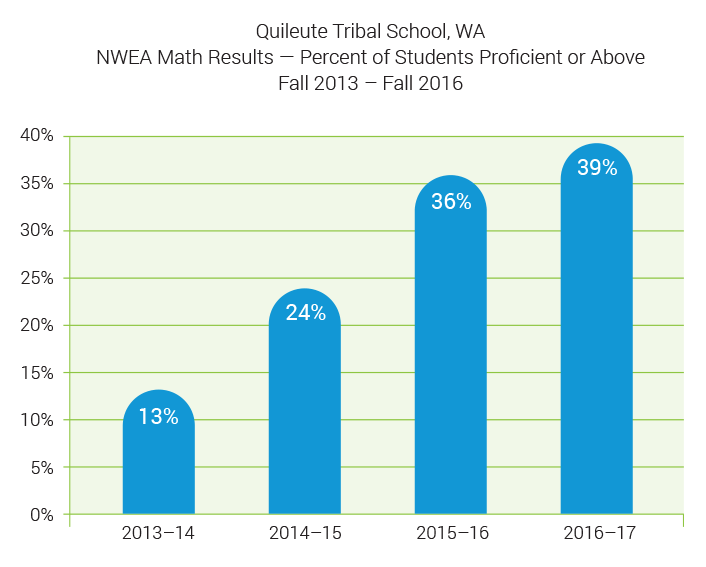Case Study
Building teachers’ knowledge and skills helps a small school achieve big gains

Quileute Tribal School in Washington State serves just 60 K-12 students but since Mark Jacobson became Superintendent at this Bureau of Indian Education (BIE) school three years ago it has been his mission to provide each and every one with a world-class education. “We view our small size as an opportunity,” shares Mr. Jacobson. “With 11 teachers we have an incredibly low student to teacher ratio which means we can put a concentrated effort toward helping each student succeed.”
When Mr. Jacobson arrived at Quileute Tribal School, located at the mouth of the Quilayute River and bordered by Olympic National Park and the Pacific Ocean, the BIE was providing funding for professional learning support from CORE to help teachers build their instructional skills. “During my first year at the school, we were working with two CORE consultants who introduced us to a lot of really good instructional strategies,” says Mr. Jacobson. “Over the next three years, we benefited from the knowledge of several other CORE consultants who began to work with us to implement those strategies.
When the BIE funding came to an end at the close of the 2015-16 school year Mr. Jacobson knew he couldn’t afford for the relationship with CORE to end. Thanks to funds from School Improvement Grants, CORE consultants Mary Buck and Sue Kaplan are once again working closely with Quileute Tribal School staff to support the effective implementation of research-based classroom practices.
Having worked with Ms. Buck and Ms. Kaplan during the previous school year, Quileute teachers were excited to continue their learning with them. According to Mr. Jacobson, “We have a great group of teachers. We’ve worked really hard to recruit the best teachers and with help from CORE, we’ve been able to create an exceptional learning environment. We haven’t had much turnover in the past two years so when Mary and Sue came in this year we were able to hit the ground running.”
A supportive partnership develops teachers’ instructional skills and confidence
During the 2016-17 school year Ms. Buck and Ms. Kaplan will each spend nine days on-site at Quileute Tribal School working side by side with Mr. Jacobson and the school’s teachers. Prior to their site visits, they talk with Mr. Jacobson about areas he’d like them to work on with teachers. “It’s so valuable to me to have another set of eyes on what we’re doing and to tap into Mary and Sue’s knowledge,” shares Mr. Jacobson.
This year’s focus for CORE at Quileute Tribal School is strengthening instruction. Ms. Buck and Ms. Kaplan are spending much of their time modeling lessons for teachers and observing teachers in the classroom. “Telling someone how to do something and how to improve is one thing but it’s much easier for teachers to understand what they need to do when they see it in action,” says Mr. Jacobson.
“Our teachers benefit so much from Mary and Sue’s expertise. They provide support and assistance in a non-threatening, non-evaluative way. They’re helping our teachers gain confidence in what they’re doing in the classroom and give them ideas on how to continue to improve. Thanks to CORE, our teachers our learning and growing in ways that measurably benefit our students.”


Hard work and a focus on effective implementation pay off
When Mr. Jacobson got to Quileute three years ago most students were below basic in both math and reading. But, as the Quileute team worked with CORE, assessment scores began to improve. By the end of the 2015-16 school year Mr. Jacobson was proud to see that NWEA MAP scores had almost tripled at every grade level over the past three years. “Our students get excited about test scores,” Mr. Jacobson shares. “We show the students their scores and then work with them to set goals and create a plan for how they’re going to improve. They know that the scores matter. There is friendly competition among the students. Each wants their class to do better than the others.”
Effective curriculum is key to continued gains
Curriculum is another area that Mr. Jacobson is focusing on this year. Last spring, he drafted a curriculum adoption policy that was approved by the school board. “Historically, teachers have found materials and programs they like and just started using them. There was no formal review or approval process. No one was evaluating curriculum to make sure it was really effective.” Mr. Jacobson is starting the curriculum adoption process with math and reading. “Mary and Sue are instrumental in the curriculum review. They are giving me input about the programs we’re evaluating and are helping us make sure all the gaps are filled.”
